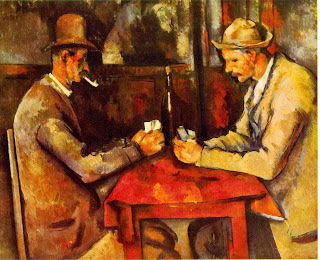 Of all nineteenth-century painters, Paul Cézanne (1839-1906) is the oldest of the Post-Impressionists and had the greatest influence on the major movements of modern art, from Cubism to Expressionism.
Of all nineteenth-century painters, Paul Cézanne (1839-1906) is the oldest of the Post-Impressionists and had the greatest influence on the major movements of modern art, from Cubism to Expressionism.  This canvas, one of a series of five studies depicting men engaged in a game of cards (left) , is a study for a larger work consisting of two pictures (currently one at the Metropolitan Museum of Art, New York and one at Le Louvre Museum, Paris) of two card players.
This canvas, one of a series of five studies depicting men engaged in a game of cards (left) , is a study for a larger work consisting of two pictures (currently one at the Metropolitan Museum of Art, New York and one at Le Louvre Museum, Paris) of two card players.From 1882 on Cézanne lived in isolation near his hometown of Aix en Provence where the distinctive shape of the mountain Ste Victoire obsessed him.
Cézanne made his largest, most complicated watercolor still lifes at the end of his career, between 1902 and 1906.
 During these years, Cézanne worked in his final studio at Les Lauves, near his native Aix-en-Provence of which the above picture gives a pretty faithful idea as it is still today as it was at the time of the death of the artist.
During these years, Cézanne worked in his final studio at Les Lauves, near his native Aix-en-Provence of which the above picture gives a pretty faithful idea as it is still today as it was at the time of the death of the artist. In 1977, the Study, part of the Barlow collection, housed at the University of Sussex Library Building, went for sale and attracted several bid up to $ 450,000 by the art dealer Hans Berguen (Zurich) but did not fetched the reserve price (500,000) and the auctioneer bought it in at $ 480,000. Later the Metropolitan Museum bought it for an undisclosed sum.

No comments:
Post a Comment